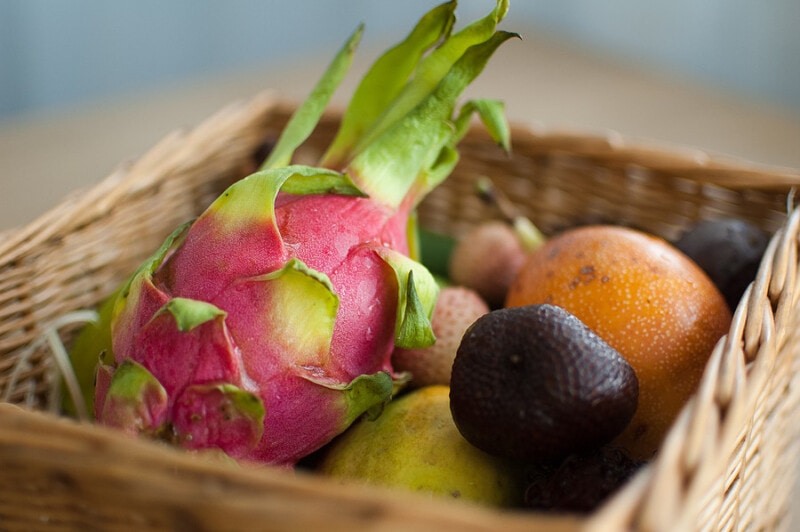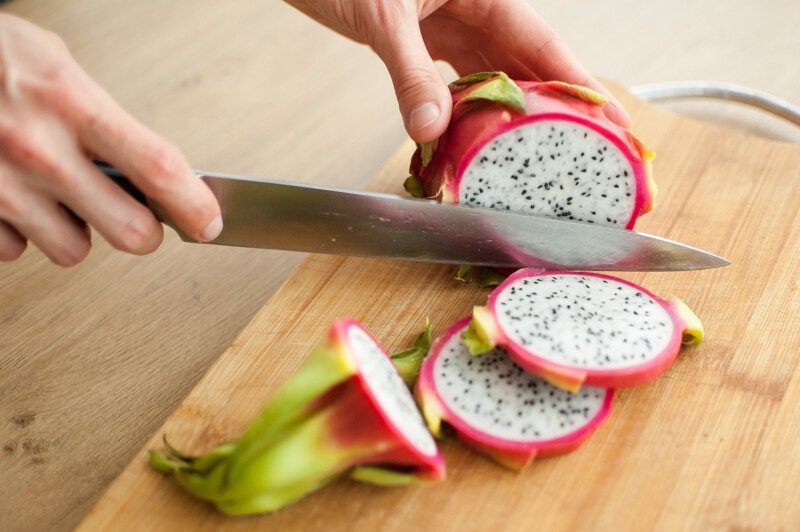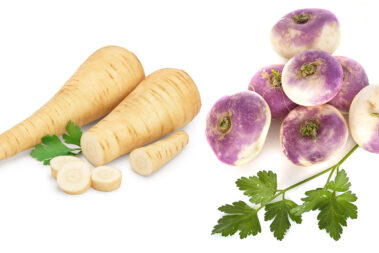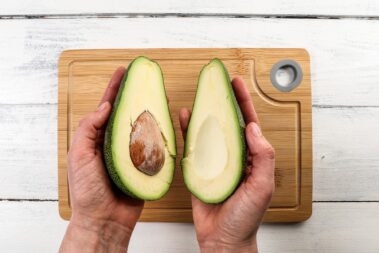Easily the most exotic-looking fruit in the world, dragon fruit has a surprisingly familiar taste but is no less worth seeking out. On top of their fantastical look and sweet flesh, the “strawberry pear” also boasts a long list of nutrients and is impressively high in iron.
Dragon fruit are produced by vining cactuses native to Mexico and Central America but are now cultivated throughout the world. They’re typically bright fuchsia with green scales and contain white flesh with numerous small black seeds. Less common varieties include fruits with fuchsia flesh and a yellow variety with bright yellow skin.
Dragon Fruit tastes slightly sweet and somewhat syrupy, reminiscent of kiwi, pear, and watermelon when it’s ripe. The texture is similar to a kiwi fruit but firmer and creamier. While ripe dragon fruit is a treat, unripe fruits are sour and bland.
To make sure your dragon fruit experience is everything it should be, keep reading. We’ll show you how to tell the ripe fruits from the unripe, how to store this exotic produce for best results, and discuss the many ways to enjoy them.
Table of Contents
How to Tell if Dragon Fruit Is Ripe
Dragon fruit, also known as pitaya or pitahaya, are produced by Selenicereus cacti. The flowers of most of these topical cacti live for only one night, with the fruits taking between 45 and 150 days to form after pollination. Despite this long ripening period, dragon fruits are plentiful throughout the summer months thanks to multiple flowering cycles.

Fruits are typically harvested before they become ripe to allow time for transport. They will continue to ripen off the plant, which means the bins at your local grocer are likely to be filled with unripe, ripe, and overripe fruit. To identify a ripe fruit, you’ll need to examine the dragon fruit’s feel, color, and bruising patterns.
Feel
A ripe fruit will give somewhat if squeezed, similar to an avocado. Too much give means the fruit is likely to be overripe. Too hard and the fruit is not yet ripe, and will need to be ripened at home.
Color
No matter what variety of dragon fruit you’re after, all ripe fruits will have vivid coloration. For typical dragon fruit varieties, this means bright, vibrant fuchsia to red coloring and scales tipped in lime green to yellow. Yellow dragon fruits should be bright lemon yellow with little to no green coloring on the scales.
Unripe dragon fruit tends to be duller in color and have more green skin than fuchsia or yellow color.
Bruising
Some discoloration is expected on ripe fruits and is often indicative of flesh that has begun to sweeten. But too much bruising or too many brown spots likely means the fruit is overripe and not worth the purchase.

How to Store Dragon Fruit
Ripe dragon fruits can be stored on the counter if you plan to eat them within a couple of days. To preserve ripe fruit for longer, put them in an airtight container and place them in the fridge.
The cool air will slow the ripening process so you can enjoy the fruit at its peak flavor even if it takes a few days to get to. And the airtight container will assure this tender fruit doesn’t absorb the flavors of the other foods in your refrigerator. Ripe dragon fruit will stay good for about a week in the fridge.
Cut dragon fruits should also be stored in the refrigerator but will only stay good for a few days. Be sure these are also stored in an airtight container.
This tropical fruit can also be frozen for longer storage. To do this, peel and cut the fruit into cubes, place them on a cookie sheet and freeze for one to three hours. Once frozen through, place the cubes in an airtight container and store them for up to six months.
Frozen dragon fruit retains its flavor but not its texture. Because of this, these frozen cubes are best used for making smoothies and homemade ice cream.
How do You Ripen a Dragon Fruit
If you end up with unripe dragon fruit, don’t fret. These tropical treats can be ripened at home given a little time.
Simply set the fruit on the counter at room temperature and allow a few days for them to ripen. You should notice the color deepen and the flesh soften. Cool temperatures will slow the ripening process while too much heat can turn an unripe fruit into an overripe fruit before you notice.
This cactus fruit tastes sweet and has a mild flavor when perfectly ripe. If your fruit lacks that sweet flavor or is overly sugary, you probably cut it open too soon or too late.
Health Benefits of Dragon Fruit
This tropical treat isn’t overloaded with any one nutrient, but it does contain a long list of vitamins and minerals offering great support to your immune system, substantial amount of dietary fiber, Vitamin C, Iron, Magnesium and is a good source of antioxidants that have many health benefits, such as, polyphenols, carotenoids and betacyanins.
Daily intake of this fruit and fruits like it have been shown to:
- Support heart health
- Decrease insulin resistance
- Improve gut health
- Reduce the risk of type 2 diabetes
How to Enjoy Ripe Dragon Fruit
This exotic fruit may look quite intimidating, but they are fairly easy to work with once you know how to handle them. Below, we’ll show you three easy techniques for accessing the flesh inside that scaly shell and tell you how to best enjoy it.

How to Cut A Dragon Fruit
Option #1: Cut and Peel
Start by cutting the dragon fruit in half along the stem axis (longways). Then peel each half by gently pushing your finger between the flesh and peel and pulling. The outer rind of ripe fruits should separate easily from the seedy flesh inside.
You can then easily dice, slice, or cube the fuchsia or white flesh. This is a great preparation option if you plan to use the fruit for a salad or to freeze it for smoothies.
Option #2: Cut and Scoop
Cut the fruit in half longways. Then use a spoon to scoop out the dragon fruit flesh, similar to how you would with an avocado. Alternatively, you can use a small melon baller to scoop out the insides.
Using a spoon is a good option if the presentation of the fruit isn’t important, like if you are adding it to a recipe or mixing it with a bowl of yogurt. A melon baller, on the other hand, is a great option for making decorative salads or fruit spreads. In this case, the hollowed-out shell makes a beautiful serving bowl!
Option #3: Peel
Perfectly ripe dragon fruits will peel with similar ease to a banana. To do this, simply make a slit in the top of the fruit and gently pull back on the skin to separate it from the flesh. The remaining ball of flesh can be sliced or diced into your preferred size and shape.
Alternatively, you can eat it whole as you pull away the peel, just as you would with a banana.

How to Use Ripe Dragon Fruit
The subtly sweet taste of dragon fruit is best enjoyed fresh. It makes a great addition to fruit salad, yogurt, and fruit platters. Frozen dragon fruit is perfect for adding a little subtle sweetness to smoothies. This nutrient-packed fruit can also be juiced if you are sensitive to that seedy texture.
The juice from the pink flesh variety of dragon fruit makes a great addition to smoothies as well as cocktails. In fact, many popular fruity alcoholic drinks contain dragon fruit, including the dragon fruit margarita and fruit lychee mimosa.
Of course, any variety of dragon fruit makes a delicious and nutritious snack all on its own. For a little added sweetness, try topping it with a little honey or sugar.
- How to Pick the Perfect Watermelon For a Sweet Summer Treat - April 10, 2024
- Future Kind’s Foundations: A Multivitamin Made for Vegans - December 5, 2023
- Does Nutritional Yeast Go Bad? - November 28, 2023







